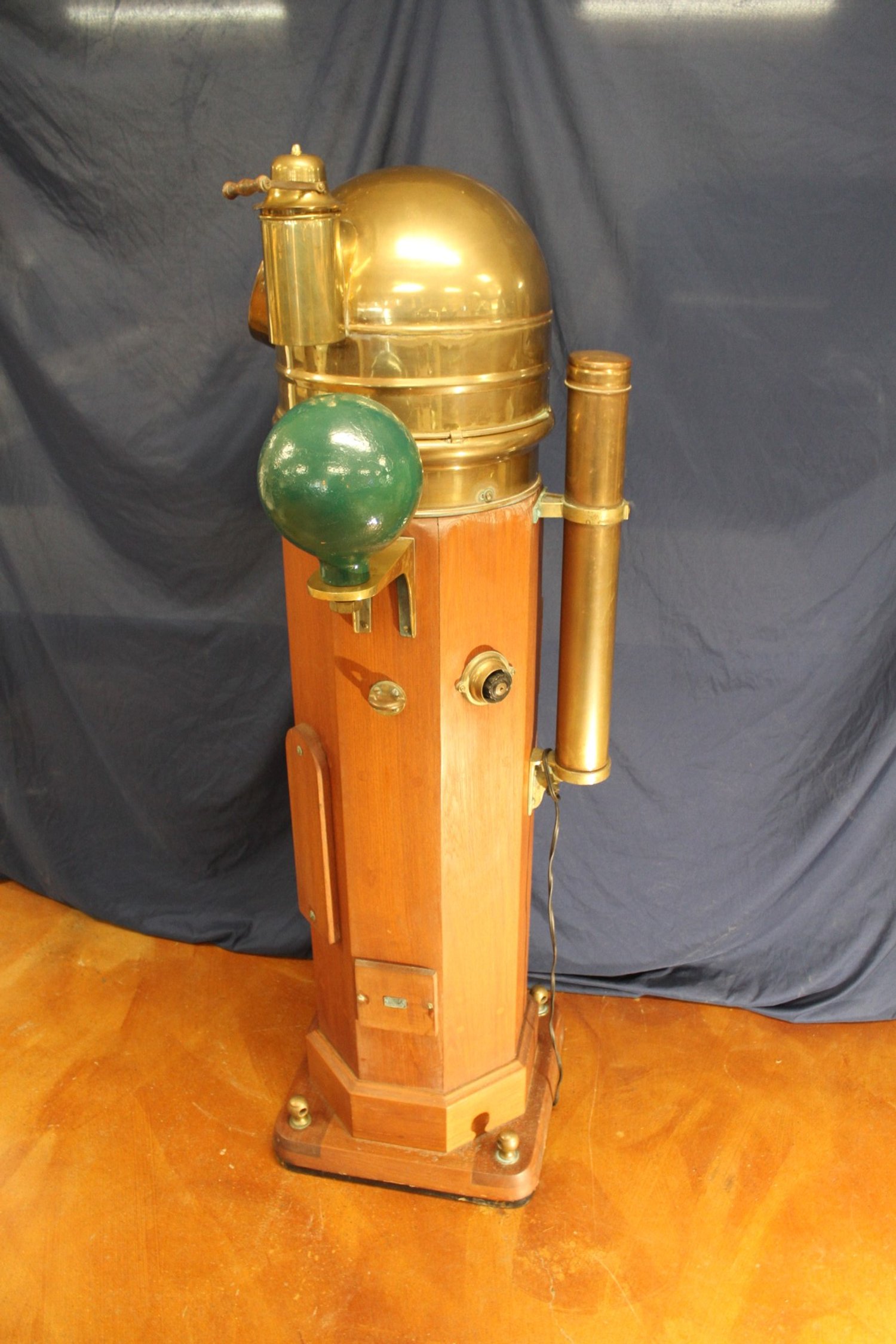#084 W. Ludolph Ship Binnacle
W. Ludolph & Co. GmbH is a German manufacturing company producing nautical and aeronautical compasses. The original company was created in 1846 by W. Ihlder. In 1867, the name changed to W. Ludolph Nautisches Institut. It was later transformed into a GmbH ("LLC" in German law) in 1908 and into an AG ("Ltd." in German law) in 1920. W. Ludolph was the first European company that broke the British monopoly of nautical compasses. At the very beginning of the 20th century, it added aeronautical compasses to its portfolio and was the first German company to build compasses for the Zeppelin, in 1906.
This W. Ludolph ships binnacle is set with a 12" (31cm) diameter compass. The compass is spirit dampened, gimbal mounted and has a Flinders Bar for stability onboard a vessel. Markings in degrees and quadrants are denoted on an azimuth ring surrounding the compass. A brass cowling, with viewing window, protects the compass and contains a functional oil lamp, originally used for lighting the compass. This binnacle has been converted to electrical illumination with white and red lights mounted within the teak octagonal pedestal. Two compensating spheres are mounted on either side and the pedestal rests on a square base. Overall dimensions are 63"H x 32"W x 20"D.
Fun fact: The port and starboard quadrantal correctors (compensating spheres) are also known as 'Kelvin's Balls' after Lord Kelvin who patented this new system of compass, the Kelvin's Compass, in the 1880s.
W. Ludolph & Co. GmbH is a German manufacturing company producing nautical and aeronautical compasses. The original company was created in 1846 by W. Ihlder. In 1867, the name changed to W. Ludolph Nautisches Institut. It was later transformed into a GmbH ("LLC" in German law) in 1908 and into an AG ("Ltd." in German law) in 1920. W. Ludolph was the first European company that broke the British monopoly of nautical compasses. At the very beginning of the 20th century, it added aeronautical compasses to its portfolio and was the first German company to build compasses for the Zeppelin, in 1906.
This W. Ludolph ships binnacle is set with a 12" (31cm) diameter compass. The compass is spirit dampened, gimbal mounted and has a Flinders Bar for stability onboard a vessel. Markings in degrees and quadrants are denoted on an azimuth ring surrounding the compass. A brass cowling, with viewing window, protects the compass and contains a functional oil lamp, originally used for lighting the compass. This binnacle has been converted to electrical illumination with white and red lights mounted within the teak octagonal pedestal. Two compensating spheres are mounted on either side and the pedestal rests on a square base. Overall dimensions are 63"H x 32"W x 20"D.
Fun fact: The port and starboard quadrantal correctors (compensating spheres) are also known as 'Kelvin's Balls' after Lord Kelvin who patented this new system of compass, the Kelvin's Compass, in the 1880s.
W. Ludolph & Co. GmbH is a German manufacturing company producing nautical and aeronautical compasses. The original company was created in 1846 by W. Ihlder. In 1867, the name changed to W. Ludolph Nautisches Institut. It was later transformed into a GmbH ("LLC" in German law) in 1908 and into an AG ("Ltd." in German law) in 1920. W. Ludolph was the first European company that broke the British monopoly of nautical compasses. At the very beginning of the 20th century, it added aeronautical compasses to its portfolio and was the first German company to build compasses for the Zeppelin, in 1906.
This W. Ludolph ships binnacle is set with a 12" (31cm) diameter compass. The compass is spirit dampened, gimbal mounted and has a Flinders Bar for stability onboard a vessel. Markings in degrees and quadrants are denoted on an azimuth ring surrounding the compass. A brass cowling, with viewing window, protects the compass and contains a functional oil lamp, originally used for lighting the compass. This binnacle has been converted to electrical illumination with white and red lights mounted within the teak octagonal pedestal. Two compensating spheres are mounted on either side and the pedestal rests on a square base. Overall dimensions are 63"H x 32"W x 20"D.
Fun fact: The port and starboard quadrantal correctors (compensating spheres) are also known as 'Kelvin's Balls' after Lord Kelvin who patented this new system of compass, the Kelvin's Compass, in the 1880s.





















